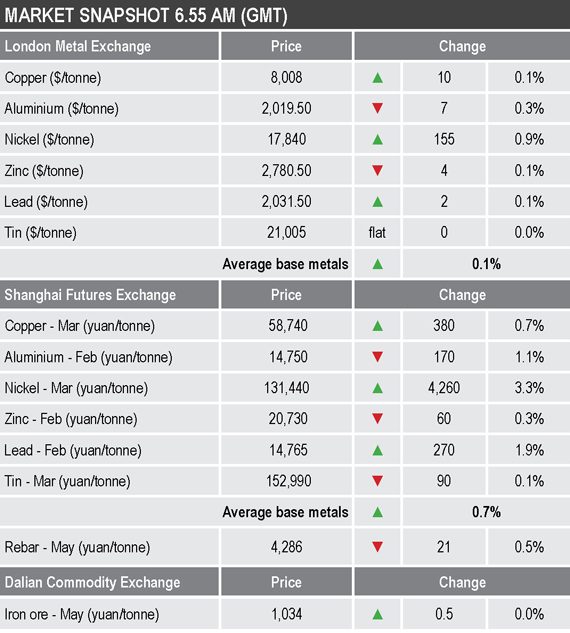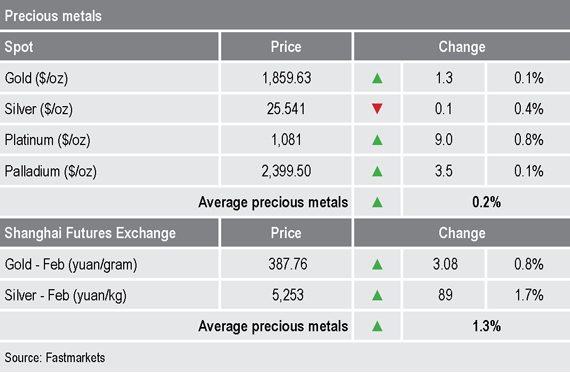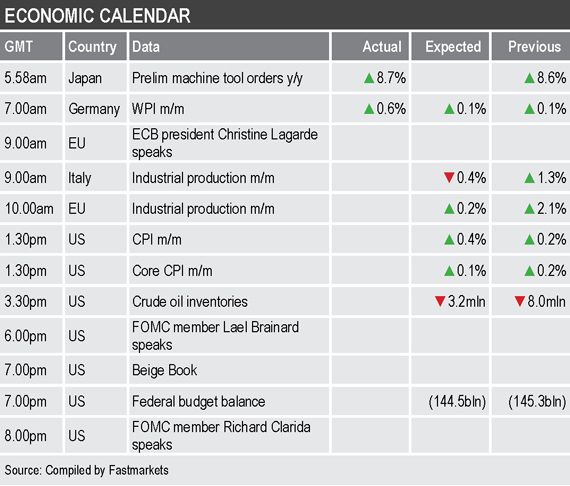Nickel prices have been moving higher while the market reacts to a mining ban on the island of Tumbagan in the Philippines and as supply from miner SLN in New Caledonia continues to be disrupted by protesters.
- Asian-Pacific equities were mixed this morning
- Dollar slipping again today after a three-day rally ended on Monday
- US treasury yields pull back from recent climb
Base metals
Three-month base metals prices on the LME were mixed this morning. Nickel led on the upside with a 0.9% gain to $17,840 per tonne, this after a correction low on Monday of $17,040 per tonne, but prices have not yet reached the recent high at $18,200. Conversely, aluminium led on the downside with a 0.3% fall to $2,019.50 per tonne, while the rest were little changed with copper up by 0.1% at $8,008 per tonne – its recent high being $8,238 per tonne.
The most-traded base metals contracts on the Shanghai Futures Exchange were for the most part firmer, led by a 3.3% gain in March nickel. February lead was up by 1.9% and March copper was up by 0.7% at 58,740 yuan ($9,083) per tonne, while February aluminium was down by 1.1%, February zinc was off by 0.3% and March tin was down by 0.1%.
Precious metals
Spot gold was up by 0.1% this morning at $1,859.63 per oz, this after a low on Monday of $1,819.15 per oz. Spot silver was down by 0.3% at $25.54 per oz, spot platinum was up by 0.8% at $1,081 per oz, while palladium was up by 0.1% at $2,399.50 per oz.
Wider markets
The yield on US 10-year treasuries has slipped and was recently quoted at 1.12%, compared with 1.15% at a similar time on Tuesday.
Asian-Pacific equities were mixed this morning: the ASX 200 (+0.11%), the Kospi (+0.71%), the Nikkei (+1.04%), the CSI (-0.33%) and the Hang Seng (-0.09%).
Currencies
The US Dollar Index has slipped and was recently quoted at 89.99, this after a high on Monday at 90.73.
The other major currencies were firmer this morning in reaction to the weaker dollar: the euro (1.2214), the Australian dollar (0.7767), sterling (1.3690) and the yen (103.66).
Key data
Economic data already out on Wednesday showed Japan’s preliminary machine tool orders were up by 8.7% year on year in December, up from an upwardly revised 8.6% gain, revised from 8%, in November. This was the second month of year-on-year gains, after 25 months of declines. Germany’s wholesale price index climbed by 0.6% month on month in December, after a 0.1% rise in November.
Data out later includes Italian and EU industrial production, with US data on consumer prices (CPI), crude oil inventories, the Beige Book and the Federal budget balance.
In addition, European Central Bank president Christine Lagarde and US Federal Open Market Committee members Lael Brainard and Richard Clarida are scheduled to speak.
Today’s key themes and views
While the rallies are looking a bit tired across the LME metals and temporary corrections seem overdue, underlying sentiment still seems to be strong and if the dollar starts to weaken again that may be another excuse for prices to remain underpinned. The prospect for more stimulus spending in the United States may well help too.
Overall, we think we are in a long-term bull market but we do think a countertrend move is somewhat overdue. We do, however, expect dips to be well supported.
Gold prices fell by 7.1% over a four-day period ending on Monday but the rebound has now paused. If US treasury yields slide again then that is likely to underpin gold, especially if the dollar weakens again too.









